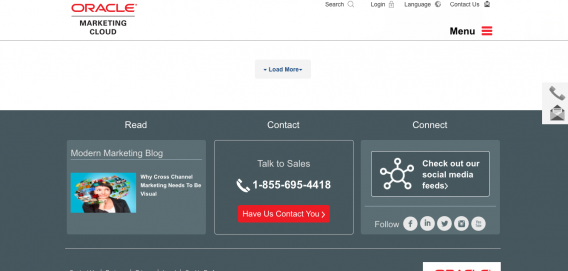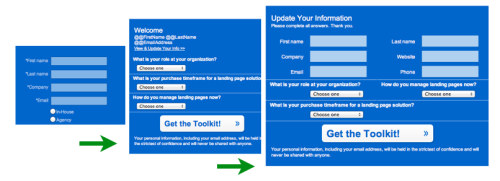Conversion optimization is a little different if you’re in B2B.
Some of the same underlying principles apply, but because of the inherent differences in buying decisions and sales cycles, pulling B2C optimization practices straight from the book might be a bad idea.
You’ll still need to do the same types of conversion research, persona building, and experimentation that is common across conversion optimization, but let’s talk a bit about how and why B2B is different.
Note: this article is heavily based on our great course with Bill Leake, CEO of Apogee Results. It’s called Optimizing for B2B. Check it out at CXL Institute.
Table of contents
Why is Optimizing for B2B Different?
There are a few things that make optimizing for B2B a different beast:
- The sales cycle is usually longer
- More people tend to be involved in buying decisions
- It’s often a higher purchase price (or at least a more complex sale)
The above points are unique but all tie back to the fact that, in B2B, you’re more closely working with a sales team.
Sales teams cost money, and of course, they also deliver another layer of organizational complexity. So instead of simply increasing the volume of leads on a landing page, you’re suddenly also supposed to factor in quality of leads, lifetime value, sales productivity, etc.
So while many usability heuristics remain the same in B2B website design and functionality, much of what goes into lead gen, sales, and analysis is different.
Think about it this way: in B2B, sometimes optimizing means aiming for less leads. When would you ever try to produce less sales in B2C eCommerce? But because of the human costs of a sales team, it makes sense to optimize for quality in B2B.
Longer Sales Cycles and Micro-Conversions
In our CXL Institute course, Bill Leake explained the differences between B2B and B2C sales cycles:

Bill Leake:
“The conversion that occurs on the website may be a very early conversion and may still be many, many months and sometimes years ahead of the sale. So, you have to approach it in a different way. It’s almost like, in some ways, the first date of something that’s leading into a relationship.
So, be thinking about the conversion experience, more as a process, rather than a one and done.
In B2B, it’s often far more complex in terms of the content marketing for conversion than B2C. In B2C, you might have thousands, if not tens of thousands or hundreds of thousands of SKUs. So, you have lots and lots of products and that brings complexity.
But in B2B, you’re often dealing with fewer products, but you not only need to take into account the persona of the person coming to your website, but where they are in the customer journey.”
So while we talk about not optimizing for micro-conversions, in B2B it becomes more important, at least to account for them. In other words, you’ll answer questions like:
- Where in the buyer journey is the person that downloads [X] whitepaper?
- Do we get a higher lead value from those who fill out a form or those who contact sales?
- What types of micro-conversions produce the highest lead values? To what points in the customer journey do they correspond?
What Are Your Goals, and What Are Your Metrics?
Since the sales process is more complex, there tend to be more people in the room for a purchasing decision. There are more conversations around buying.
When you want to buy a pair of jeans from Bonobos, you often don’t need much of a nudge. Sure, you still need to be reached with the right message at the right time, but the buyer journey is much less complicated than a complex B2B purchase.
It’s something that people deliberate upon. They ask and negotiate budgets for technology or corporate development.
But when they come to your site, they could be at any given stage:
- They might be looking to buy.
- They may have been a customer before.
- They may be coming to research and see if it’s something they need.
- They may have just stumbled across it accidentally.
In order to maximize the value of your website, you need to define goals for each of these stages and how you can track them across the purchasing journey.
Typically, the big goal is leads (can mean many things). But a lot goes into a good quality lead, and there are different stages of measurement. Generally, as a marketer, you’re focusing on compiling MQLs (marketing qualified leads). What this means depends on the company, but it can take into account different metrics like pathing, time on site, video engagement, company size, role, etc. So the process in B2B looks a bit like this (simplified):
Visitor → MQL → SQL → customer
For further reading on B2B goals and measurement, check out this article on better measuring lead generation.
Account-Based Marketing
Something else unique in B2B is what’s known as Account-Based Marketing. As Bill Leake explained:

Bill Leake:
“The other thing that you typically want to look at as well in many B2B cases, some goals for account-based marketing. Because you might have four different folks of the company who hit your website at different places.
So if a sale is worth six figures to you or more and you see that somebody from IBM is on your website, you’ll probably spend a lot more time or you should spend more time trying to figure out who they are and what they were doing, than if you’re running a large retail website and some random person from Hotmail.com or AOL.com hits your site.
There you want to look at things in clumps and aggregates. But in an account-based marketing thing, you might even want to throw up some things like Demandbase on the high end to LeadLander on the low end that do help you resolve IP addresses into companies, so you know which companies hit your website.
If they spent a certain amount of time, figure out from list purchases or your house list, “Who else do we know at that place?” Then, actually have some outbound that cascades into that company based on the inbound.”
In any case, B2B optimization starts with building and understanding personas. Who is your ideal customer profile? How do they buy? What content and information do they like?
Building Personas
A big part of B2B mastery is understanding and building buyer personas.
Because of the complexity of decision making that is often involved, and the fact that many people are in the discussion of whether or not to buy, it’s tough to map out which personas you should be targeting.
It’s just as hard, if not more so, to map out where these personas are in the customer journey and what type of content to serve them depending on the stage.
Personas should be nothing new to our audience, but if you want to brush up, here’s an article (and if you want extra credit, take our Rigorous User Personas course in the Institute).
Cross reference the personas you’ve created with your historical customers as well as who you want to be your customers. Try to analyze the top 10% of clients you’d like, and figure out what they have in common.
Also, look into those that evangelize your company, your top referrers. What do they have in common?
In addition, there may be multiple personas you need to address with different campaigns and pages. For instance, CXL Institute has a variety of personas, both in-house and agencies. Employees and managers. We approach each sale with a different messaging strategy.
From there, you must optimize your content.
Optimizing Your Content
Most B2B sites are multi-purpose vehicles.
Historically, lots of B2B sites have acted as big brochures. People’s attention spans tend to be getting shorter though, and they want content that’s easier to consume.
Depending on your personas and sales process, your content could be a few different things:
- Long form content has plenty of benefits, like thought leadership, SEO traffic, and authority building pieces.
- Short form can be good too, especially for top of funnel content and concise product-based content.
- Webinars perform particularly well in a B2B context. You can also tease out more information from these and better qualify leads for your sales team.
- Whitepapers are a classic. There are even new ways of optimizing and testing whitepaper content.
- Videos are great, and often underplayed in the B2B context.
You get the point – there are lots of different approaches to content in B2B.
The main thing is to align your content with your customer personas as well as where they are in the customer journey – how ready are they to purchase? Then you create your content with that in mind, and optimize the call to action based on the presumed and desired intent at that stage…
Optimizing CTAs
What are you trying to sell? How many touch points do you need? Web-based sale or phone call?
Some sites, like Optimizely, prioritize the demo:
Others, like Oracle, want you to call their sales team right away:
And still more sites (usually lower purchase prices), let you jump in with a free trial, or simply let you purchase on the site. VWO here:
The CTA on a B2B site is where the money is to be made; it’s what the sale is predicated on. Bill Leake explains very well the different strategies you can use:

Bill Leake:
“Our client had a really, really strong tech team, and when they got somebody signed up for their demo, the thing sold itself. They converted like 60% of demos into customers once the demo was activated.
So for us, in that case, the right answer was get them into the demo. Make it as easy as possible to the demo and the demo sells itself. There are lots of pieces of software out there where you don’t want them to go anywhere near the demo, because it’s fugly, it doesn’t work, or it breaks, or it doesn’t showcase, or there are a bunch of other questions people are going to have.
So it’s really understanding what do we have to work with today, what are we gonna have to work with next quarter. One of the things you have to be thinking through all the time is are we still working with the best call to action. Sometimes it’s a phone call.
Amazingly enough, most people in conversion have historically focused on getting the web form. If you’re in B2B or any high dollar sale, you know what, when you have a human talking to a human, if you’ve got the right team, close rates go up, and attachment and upsell rates go up. So you typically walk people into a more lucrative higher margin sale.
Dell computers knew that for years.
Dell computer would have teaser items that were cheap to get someone called in, and the stuff that got added to their shopping cart wasn’t so cheap. And then a lot of margin got added to the order. Online it’s fairly easy to people to cost compare and kind of strip all the margin out of orders.
Sometimes you’re optimizing for a phone call, and sometimes make it clear that this offer is only available if you call.”
In addition, Bill explained, people tend to over optimize for email list subscribers without qualifying the leads. If you have a super compelling offer for your email list, and you don’t require qualifying fields, you’ll tend to get a lot of leads but a low ratio of qualified leads.
This doesn’t sound like a problem until your analyst goes in and tries to segment leads and quantify your marketing efforts. It’s hard work at that point.
Using Dynamic Content
Your landing pages need to be hyper-specific to your customer persona. If not, people don’t take leaps of faith – the landing page needs to talk to their specific problems.
This isn’t specific to B2B – you should always align your pages with your customers’ expectations. But B2B customers tend to exhibit more heterogeneity because of the problem of multiple buyers and roles. As Scott Brinker said in Search Engine Land:

Scott Brinker:
“In B2B, where respondents are more risk aware, they’re even less comfortable making leaps of assumption. If your landing page doesn’t specifically call out the issue they were searching for—or fulfill a promise you dangled in the ad copy—they’re more likely to abandon you and go in search of a stronger “information scent” elsewhere.”
Don’t Forget Emotions
Remember that whether you’re selling to businesses or consumers, the end buyer is always human, and humans are never totally rational. In fact, B2B buyers tend to be specifically risk averse, as Scott Brinker outlined in Search Engine Land:

Scott Brinker:
“See, if I buy a new TV and then realize a couple of months later that I made a bad choice, the consequences are limited. I’m disappointed, and my wife might make a few wise remarks, but we move on. However, if I’m a key decision-maker for a new enterprise HR system—and then several months and hundreds of thousands of dollars later it becomes clear that we made a disastrous decision—I can suffer real damage to my career.”
Lead Types: How Much Info Should You Collect?
There’s a saying in software development that applies to B2B lead gen: do you want it fast, good, or cheap?
Cheaper leads tend not to be as qualified, and if it’s more expensive, it’s probably that there are either more (easier to sift through for cheaper price points) or they’re higher quality.
Anyway, this is a sales and operations decision based your product and market. Outside the scope of this article.
What is inside the scope of this article, though, is how you collect and vet inbound leads based on what your company decides.
If you have a multi-tier sales engine where, if you have any contact info, they can be contacted, you can have more leads. Usually, though, you want to have as much information as possible on your leads without sacrificing too much on the quantity side of things.
One possible way of bridging the gap between poor lead quality and high-friction forms is progressive profiling. Each time your prospect fills out a new form, you collect additional information, piece-by-piece – instead of a daunting form asking for everything all at once.
Lead Scoring and Prioritization
In B2B, it’s not simply “they converted; we’re done.”
After someone fills out a form, or attends a webinar, or whatever, how do you determine whether this person is an MQL to be passed onto the sales team? How do you score them and prioritize them?
Lead scoring is complicated. Like any model, it’s probably not going to completely align with what is capital T True. But a good model will definitely help you waste less time on the sales front and optimize your approach on the marketing front.
Lead scoring also tends to be quite unique to your business, though there do tend to be common correlative indicators of lead quality. Again, lead scoring is a bit outside the scope of this article, and there are so many good resources on the topic already:
- The Definitive Guide to Lead Scoring by Marketo
- Lead Qualification: Don’t BANT. Just CHAMP!
- Create an Effective Lead Scoring System in 7 Steps
- 5 Best Practices for a Successful Lead Scoring Model
Conclusion
This article is only a short outline of B2B optimization and the ways it differs from more transactional B2C optimization. Of course, the devil is in the details and it’s all about execution; you can read about long term sales cycles, building personas, and lead scoring, but there’s a lot of work that goes into each of those that is specific to your own business.
The one takeaway here is probably that B2B sales cycles are different. The higher the cost of the item, the more inherent friction there is as well as complexity. Your website strategy has to reflect that, as well as take into account the costs and efficiency of a human sales force. It’s not easy.









I am studying business and I am interesting at your program B2B.